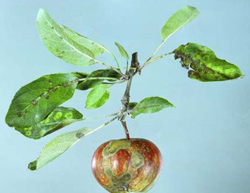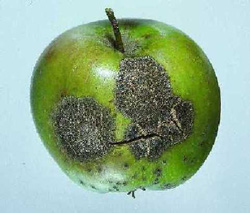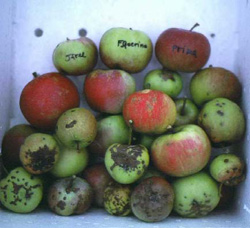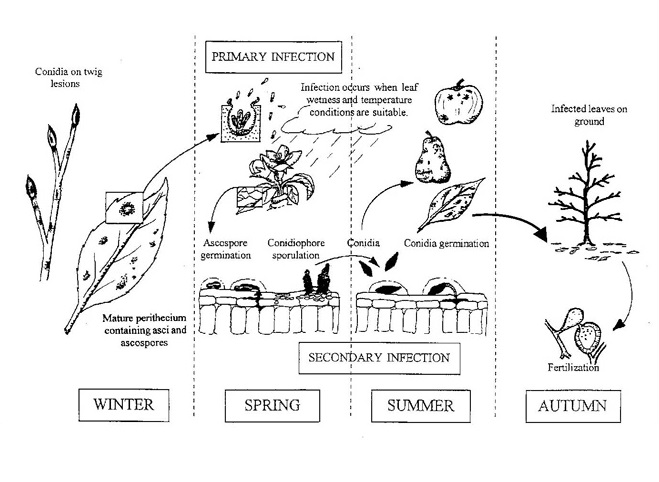Apple scab
Apple scab, or black spot, is caused by the fungus Venturia inaequalis. It infects:
- leaves
- shoots
- buds
- blossoms
- fruit
It occurs almost everywhere apples are grown and is the most serious and widespread disease of this crop, especially in regions with high rainfall and relative humidity during the growing season.
Host plants and cultivars
Apple scab occurs on apple, crab-apple and other species in the genus Malus. A different but closely related species occurs on pear.

All the major apple cultivars grown in Victoria are susceptible to scab. The most highly susceptible cultivars are:
- Cripps Pink (including Pink Lady™)
- Lady William.
Some cultivars show some resistance, including:
- Jonathan
- Bonza.
Scab-immune cultivars with yet limited commercial appeal have been bred overseas. Some of these have been introduced through plant quarantine and might be of interest to growers seeking specialist markets:
- Priam
- Prima
- Priscilla
- Redfree
- Jonafree
- Florina-Querina.
For the home garden, the following are considered resistant:
- Crimson Crisp-cv. 'Co-op 39'
- Pixie Crunch-cv. 'Co-op 33'
Please note that resistance to apple scab may not be durable (CABI, 2020).
Symptoms of apple scab

The following symptoms can indicate apple scab:
- Small spots on the underside of young leaves or as spots on either surface of older leaves. The spots (or lesions) are brown or olive-green and have an indefinite margin at first.
- The lesions on older leaves are more definite in outline and become velvety-grey to sooty black.
- Sometimes the tissue below individual lesions becomes raised, giving such leaves a blistered, scabby appearance.
- The lesions merge to cover most of the leaf surface if infection is severe. Infected leaves are often twisted, distorted and stunted and tend to fall prematurely.
- The fungus may infect developing flowers but is more usually seen on reproductive parts after the fruit has set. Infection of fruit stalks usually causes the young fruit to fall.
- Early infection of the fruit itself can cause distortion because growth under the lesion stops while the surrounding tissue develops normally.
- Late infections on more mature fruit appear as dark, roughly-circular spots. The centres of large lesions become dry and corky and a greyish, raised cuticle might be evident along the border of the lesion.
- The corky areas may crack, allowing entry of fruit-rotting. Infection of almost-mature fruit results in small spots with little distortion of the fruit. Lesions may continue to develop in storage from symptomless infections present before harvest, resulting in storage scab.
Economic importance
Apple scab is present throughout Victoria, but is most serious in districts with high rainfall, especially in spring. The disease can reduce the quality and size of fruit. It can also cause premature fruit drop, defoliation and poor development of fruit buds in the next season. Under favourable conditions and without control measures, apple scab can cause total crop failure.
At present, the potential threat of infection can be overcome only by a costly spraying program. This requires much labour, machinery and sprayed chemicals and involves up to 12 sprays each season.
Disease cycle
The apple scab fungus usually survives over winter under the trees, in the dead, infected leaves from the previous season. Occasionally, twig infections, infected bud scales or infected leaves that remain on the tree over winter can provide an overwintering source of spores. Leaves infected with the apple scab fungus usually fall from trees in autumn or early winter.

The fungus continues to live within the leaves during winter, forming small, flask-shaped bodies, in which spores (ascospores) develop. These ascospores mature in spring and are forcibly ejected during spring rains.
The time when ascospores mature coincides with the period of rapid development of buds, flowers and leaves. Ascospore discharge occurs over a period of about 8 to 12 weeks. Mature ascospores are present by early September, and the greatest numbers of ascospores are released from late September to mid-November. This is the high-risk period for infection with apple scab.
Small numbers of ascospores are released during December. The discharge of ascospores in spring depends on moisture, temperature and light. Some ascospores are released about 30 minutes after the start of rain, and about 75 per cent of mature ascospores are released within 3 hours. Temperatures close to freezing decrease liberation of ascospores.
Most ascospores are released during daylight. Night discharge and any discharges into dew are less important. Wind currents carry ascospores to developing flowers, fruits and leaves, where they adhere quickly on contact, and resist removal by more rain.
Ascospores germinate and grow into the tissue if fruit or green leaves are wet when ascospores lodge, and if they remain wet long enough. The time needed for germination and infection varies with the temperature and is called the infection period (see Table 1).
The fungus grows under the cuticle of leaves and fruit and sends up stalks on which summer spores (conidia) are borne. This is when the typical scab lesions can be seen and happens after about 9 to 17 days (depending on the prevailing temperature – (see Table 1).
Conidia, produced in large numbers, are washed or splashed to new locations during rain. They germinate and form new infections if the temperature and moisture are suitable. This continues during summer and autumn rains.
An important difference between ascospores and conidia is that release of the conidia doesn't depend on light. Infected leaves fall to the ground in autumn and the disease cycle continues.
Table 1 – Infection periods
This table shows the number of hours that leaves or fruit must remain wet at various temperatures for infection to occur, and the time after infection has begun for scab lesions to appear.
| Average temperature °C | Hours of wetting required for infection1 | Days required for scab lesions to appear2 |
|---|---|---|
| 5.5 | 30 | — |
| 7 | 20 | more than 17 |
| 10 | 14 | 16 |
| 13 | 11 | 14 |
| 14 to 15 | 10 | 12 |
| 15.5 | 9.5 | 11 |
| 16 to 16.5 | 9 | 10 |
| 17 to 24 | 9 | 9 |
| 24.5 | 9.5 | — |
| 25 | 11 | — |
1Average temperature for the period determined from hourly readings
2Average temperature determined from daily maximum and minimum temperatures (after W.D. Mills)

Control measures
Control measures are designed to interrupt the life cycle at various stages and to modify the orchard environment to reduce disease. When planning a new orchard:
- use scab-resistant varieties where practical
- avoid locations with high spring rainfall
- use dwarfing rootstocks and training systems to maintain an open and easily sprayed tree canopy
- avoid use of overhead irrigation, which could begin or prolong scab infection periods
- plan the orchard to allow for sanitation practices such as mulching of overwintering leaves.
At present the main methods of control are:
- using protectant and post-infection sprays in spring
- sanitation practices to reduce scab carryover.
Protectant spray programs remain the basis of effective apple scab control, especially where disease pressure is high. They can be supplemented by the use of post-infection sprays and autumn sanitation practices.
Protectant sprays
Protectant sprays of suitable fungicides are needed at green tip, pink bud and at regular intervals afterwards. This is to make sure that rapidly developing leaves and fruits are covered with a fungicide residue that will prevent spores from germinating.
Post-infection sprays
Some fungicides have the capacity to kill or suppress established infections. The period of curative action is short. If curative fungicides are to be effective, they must be applied within a few days from the beginning of the wet period that started the infection period and not from when scab lesions are first visible.
Most fungicides won't cure an established apple scab infection after the lesion becomes visible to the naked eye, but some will suppress the formation and germination of spores on the established lesion as long as spray residue remains.
Both mechanical and electronic instruments that can record leaf wetness and temperature in the orchard are available. Data from these instruments, when combined with the table of infection periods (see Table 1) enable the grower to determine when scab infection conditions have occurred. This knowledge allows more precise timing of scab sprays.
In orchards with a low risk of disease, such as those in irrigation districts where rainfall in spring is low, a control program based only on post-infection sprays can be followed. This can save several applications of spray when compared with a routine program of spraying protectants.
Post-infection sprays, based on accurate knowledge of infection periods, can also supplement a program of protectant sprays.
Sanitation to reduce scab carryover
Primary infection of apple scab is mainly caused by ascospores released from infected leaves that overwinter on the orchard floor. The higher the density of ascospore inoculum, the faster and more intense the resultant scab epidemic.
Sanitation practices can reduce the risk of scab build up in spring and improve the efficiency of scab control programs. Sanitation practices are defined as management practices that reduce or eliminate the development and production of primary inoculum (ascospores) before the start of susceptible tissue growth in spring.
Some practical sanitation practices are:
- Treat leaves on the tree immediately before the leaves fall with a nitrogenous fertiliser to speed up leaf breakdown.
- Mulch the leaf litter after the leaves fall. Sweep leaves into rows and use a mechanical shredder, slasher or flail mower to chop leaves into small pieces that then break down more rapidly. Leaf sweepers are available commercially.
- Combine leaf mulching with the ground application of a nitrogenous fertiliser.
Storage scab
Infection periods that occur shortly before harvest can result in the development of storage scab. These spots develop slowly on fruit in storage as a result of infection in the orchard, and not from the contamination of fruit after harvest.
For this reason, it's important to apply suitable fungicide sprays if infection periods occur shortly before harvest and inoculum in the form of secondary infection is present in the trees.
Minimise resistance to fungicides
When planning a control program for scab, limit the use of fungicides that have a high risk of developing resistant strains of scab. Where possible, use multi-site fungicides as they are at less risk from resistance than fungicides in all other activity groups.
Consult chemical resellers about the fungicides and the most appropriate time to spray in your situation.
For information on currently registered and or permitted chemicals, check the Australian Pesticide and Veterinary Medicine Authority (APVMA) website.
Always consult the label and Safety Data Sheet before using any chemical product.
Monitor for potential overwintering scab
Check levels of leaf infection in all blocks after harvest to estimate the potential level of scab that can overwinter and initiate primary infection in the following spring.
Note that estimates of scab potential based on fruit scab levels are not a good indication of potential scab infection in the following season, because the disease doesn't carryover on infected fruit.
Correct diagnosis
Correct diagnosis is essential for effective pest and disease control.
Reporting an unusual plant insect pest or disease
Report any unusual plant pest or disease immediately using our online reporting form or by calling the Exotic Plant Pest Hotline on 1800 084 881. Early reporting increases the chance of effective control and eradication.
Please take multiple good quality photos of the pests or damage to include in your report where possible, as this is essential for rapid pest and disease diagnosis and response.
Your report will be responded to by an experienced staff member, who may seek more information about the detection and explain next steps.
Report onlineReference
CABI, 2020. Venturia inaequalis (apple scab). In: Invasive Species Compendium. Wallingford, UK: CAB International